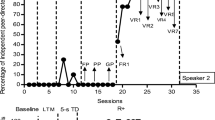Abstract
Therapists and educators frequently teach alternative-communication systems, such as picture exchanges or manual signs, to individuals with developmental disabilities who present with expressive language deficits. Michael (1985) recommended a taxonomy for alternative communication systems that differentiated between selection-based systems in which each response is topographically identical (e.g., card selection and exchange systems) and topography-based systems in which each response is topographically distinct (e.g., signed language). We compared the efficiency of training picture exchanges and signs with 3 participants who presented with severe language deficits; all participants acquired the picture-exchange responses more readily.
Similar content being viewed by others
References
Baer, D. M., Peterson, R. F., & Sherman, J. A. (1967). The development of imitation by reinforcing behavioral similarity to a model. Journal of the Experimental Analysis of Behavior, 10, 405–416. doi: 10.1901/jeab.1967.10-405
Bondy, A., & Frost, L. (1994). The picture exchange communication system. Focus on Autistic Behavior, 9, 1–17.
Carr, E. G., & Durand, V. M. (1985). Reducing behavior problems through functional communication training. Journal of Applied Behavior Analysis, 18, 111–126. doi: 10.1901/jaba.1985.18-111
Chambers, M., & Rehfeldt, R. A. (2003). Assessing the acquisition and generalization of two mand forms with adults with severe developmental disabilities. Research in Developmental Disabilities, 24, 265–280.
Finn, H. E., Miguel, C. F., & Ahearn, W. H. (2012). The emergence of untrained mands and tacts in children with autism. Journal of Applied Behavior Analysis, 45, 265–280. doi: 10.1901/jaba.2012.45-265
Fisher, W., Piazza, C. C., Bowman, L. G., Hagopian, L. P., Owens, J. C., & Slevin, I. (1992). A comparison of two approaches for identifying reinforcers for persons with severe and profound disabilities. Journal of Applied Behavior Analysis, 25, 491–498. doi: 10.1901/jaba.1992.25- 491
Fisher, W. W., Piazza, C. C., Bowman, L. G., & Amari, A. (1996). Integrating caregiver report with a systematic choice assessment. American Journal on Mental Retardation, 101, 15–25.
Gregory, M. K., DeLeon, I. G., & Richman, D. M. (2009). The influence of matching and motor-imitation abilities on rapid acquisition of manual signs and exchange- based communicative responses. Journal of Applied Behavior Analysis, 42, 399–404. doi: 10.1901/jaba.2009.42-399
Hanley, G. P. (2010). Toward effective and preferred programming: A case for the objective measurement of social validity with recipients of behavior-change programs. Behavior Analysis in Practice, 3, 13–21.
Lamarre, J., & Holland, J. G. (1985). The functional independence of mands and tacts. Journal of the Experimental Analysis of Behavior, 43, 5–19. doi: 10.1901/jeab.1985.43-5
Michael, J. (1985). Two kinds of verbal behavior plus a possible third. The Analysis of Verbal Behavior, 3, 1–4.
Michael, J. (1988). Establishing operations and the mand. The Analysis of Verbal Behavior, 6, 3–9.
Richman, D. M., Wacker, D. P., & Winborn, L. (2001). Response efficiency during functional communication training: Effects of effort on response allocation. Journal of Applied Behavior Analysis, 34, 73–76. doi: 10.1901/jaba.2001.34-73
Skinner, B. F. (1957). Verbal behavior. New York: Appleton-Century-Crofts.
Slocum, S. K., Miller, S. J., & Tiger, J. H. (2012). A blocked-trials procedure to teach identity matching to a child with autism. Journal of Applied Behavior Analysis, 45, 619–624. doi: 10.1901/jaba.2012.45-619
Sundberg, C. T., & Sunderg, M. L. (1990). Comparing topography-based verbal behavior with stimulus selection-based verbal behavior. The Analysis of Verbal Behavior, 8, 31–41.
Thompson, R. H., Cotnoir-Bichelman, N. M., McKerchar, P. M., Tate, T. L., & Dancho, K. A. (2007). Enhancing early communication through infant sign training. Journal of Applied Behavior Analysis, 40, 15–23. doi: 10.1901/jaba.2007.40-15
Thompson, R. H., McKerchar, P. M., & Dancho, K. A. (2004). The effects of delayed physical prompts and reinforcement on infant sign language acquisition. Journal of Applied Behavior Analysis, 37, 379–383. doi: 10.1901/jaba.2004.37-379
Tincani, M. (2004). Comparing the picture exchange communication system and sign language training for children with autism. Focus on Autism and Other Developmental Disabilities, 19, 152–163.
Wallace, M. D., Iwata, B. A., & Hanley, G. P. (2006). Establishment of mands following tact training as a function of reinforcer strength. Journal of Applied Behavior Analysis, 39, 17–24. doi: 10.1901/jaba.2006.39-17
Wraikat, R., Sundberg, C. T., & Michael, J. (1991). Topography-based and selectionbased verbal behavior: A further comparison. The Analysis of Verbal Behavior, 9, 1–17.
Ziomek, M. M., & Rehfeldt, R. A. (2008). Investigating the acquisition, generalization, and emergence of untrained verbal operants for mands acquired using the picture exchange communication system in adults with severe disabilities. The Analysis of Verbal Behavior, 24, 15–30.
Author information
Authors and Affiliations
Corresponding author
Additional information
This study was based on a thesis submitted in partial fulfillment for the first author’s Master of Arts degree at Louisiana State University.
Rights and permissions
About this article
Cite this article
Barlow, K.E., Tiger, J.H., Slocum, S.K. et al. Comparing Acquisition of Exchange-Based and Signed Mands With Children With Autism. Analysis Verbal Behav 29, 59–69 (2013). https://doi.org/10.1007/BF03393124
Published:
Issue Date:
DOI: https://doi.org/10.1007/BF03393124




